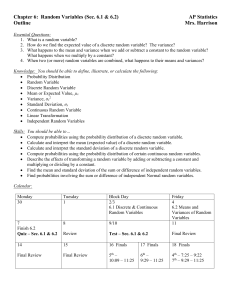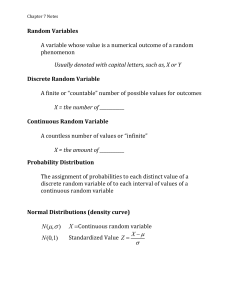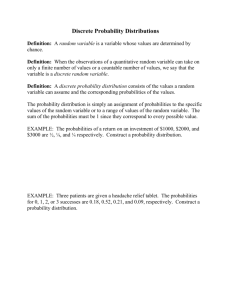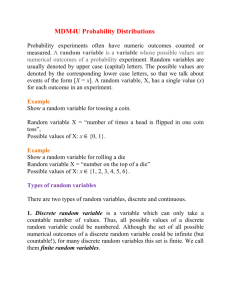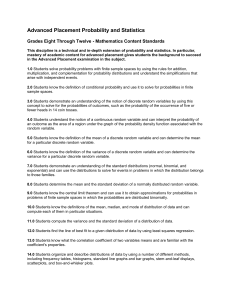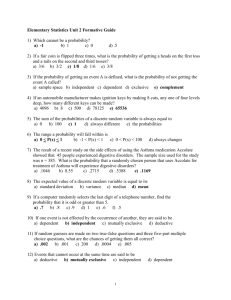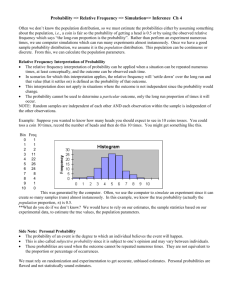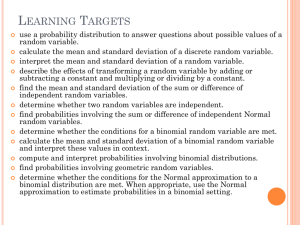Combining Random Variables
advertisement
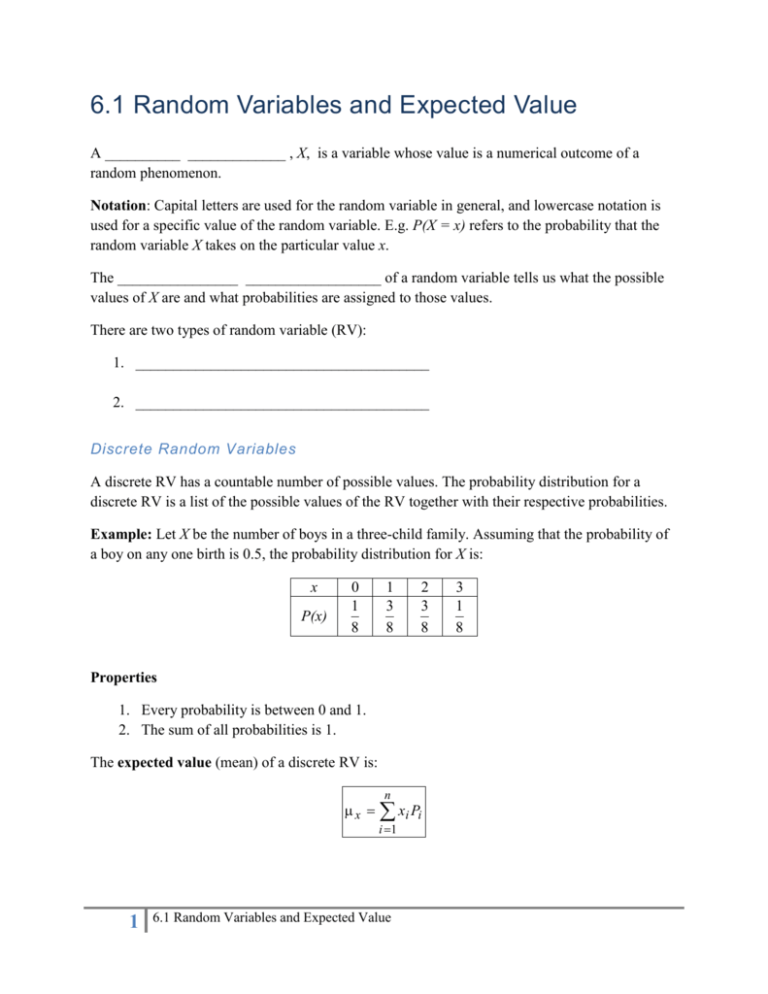
6.1 Random Variables and Expected Value A __________ _____________ , X, is a variable whose value is a numerical outcome of a random phenomenon. Notation: Capital letters are used for the random variable in general, and lowercase notation is used for a specific value of the random variable. E.g. P(X = x) refers to the probability that the random variable X takes on the particular value x. The ________________ __________________ of a random variable tells us what the possible values of X are and what probabilities are assigned to those values. There are two types of random variable (RV): 1. _______________________________________ 2. _______________________________________ Discrete Random Variables A discrete RV has a countable number of possible values. The probability distribution for a discrete RV is a list of the possible values of the RV together with their respective probabilities. Example: Let X be the number of boys in a three-child family. Assuming that the probability of a boy on any one birth is 0.5, the probability distribution for X is: x P(x) 0 1 8 1 3 8 2 3 8 Properties 1. Every probability is between 0 and 1. 2. The sum of all probabilities is 1. The expected value (mean) of a discrete RV is: n x xi Pi i 1 1 6.1 Random Variables and Expected Value 3 1 8 The variance of a discrete RV is: n 2x ( xi x )2 Pi i 1 The standard deviation of a discrete RV is: x 2x n ( xi x )2 Pi i 1 Example: In the example above find the following: 1. P( X 2 ) 2. x 3. x A probability histogram of a discrete RV is a way to picture the probability distribution. 2 6.1 Random Variables and Expected Value Continuous Random Variables A continuous RV takes all the values in an interval of numbers. Properties 1. The probability distribution of X is described as a density curve (a function always on or above the x-axis that has area exactly 1 between it and the horizontal axis). 2. The probability of any event is the area under the density curve. The probability of any individual event is 0. 3. The distinction between and is ignored when finding probabilities for continuous RV. i.e. P(a < X < b) = P(a £ X £ b) = P(a < X £ b) = P(a £ X < b) . The normal distribution is an example of a probability distribution and the normal curve is a density curve. Worksheet: “Transforning and Combining Random Variables” Transforming Random Variables The random variable X can be transformed by adding a constant to each value, or by multiplying each value by a constant, or some linear combination of the two. The rules for the mean, variance and standard deviation of the new transformed random variable are: a bX a b X a2bX b 2 X2 a bX b X Notice the similarity to the rules for the statistics of one variable data (remember “rescaling and recentering”?). 3 6.1 Random Variables and Expected Value Combining Random Variables Sometimes you may also wish to combine two different random variables. The rules for the mean, variance and standard deviation of the combined random variables are not so straightforward: mean m X +Y = m X + mY m X -Y = m X - mY variance s 2X +Y = s 2X + s Y2 if and only if X and Y are independent s 2X -Y = s 2X + s Y2 if and only if X and Y are independent standard deviation s X +Y = s 2X + s Y2 if and only if X and Y are independent s X -Y = s 2X + s Y2 if and only if X and Y are independent Notice how you only ever add variances, even if the two random variables are subtracted. NEVER ADD STANDARD DEVIATIONS. Example 1: Consider a distribution with X 14, X 2. Multiply each value of X by 4, and then add 3 to each. Find the mean and standard deviation of the transformed random variable. s 3+4 X = m3+4 X = Example 2: X is the number of cars that Linda sells. Cars Sold (X) Probability 0 0.3 1 0.4 2 0.2 3 0.1 Y is the number of trucks and SUVs that Linda sells. Trucks & SUVs Sold (Y) Probability 0 0.4 1 0.5 2 0.1 mY = mX = At her commission rate of 25% of gross profit on each vehicle she sells, Linda expects to earn $350 for each car sold and $400 for each truck or SUV sold. So her earnings, Z, are: Z = __________________________________ Linda’s mean earnings are: mZ = 4 6.1 Random Variables and Expected Value

